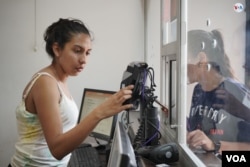On the road that leads from Cúcuta to the municipality of Chinácota, in the border department of Norte de Santander in Colombia, you can still see Venezuelan walkers in search of a better life. In their hands they carry cars, backpacks, bags and many of them carry babies on their shoulders.
It is a photograph that has been observed since 2015, when the total closure of the border with Venezuela became effective. At that time, there were 644,144 Venezuelan citizens who entered that area in search of better opportunities.
As of today, the figures from Colombian Migration indicate that between January and February 2023, 85,894 Venezuelans crossed into Colombian territory. They average ages between 18 and 39 and decided to settle mainly in cities such as Bogotá (42,934), Cúcuta (15,281) and Medellín (7,589).
Some 171,559 Venezuelans entered and left between January and February 2023 through the Colombian border, with the capital of Norte de Santander being the first stop they make and the final destination for those who, due to resources or forces, do not continue on the road.
This scenario contrasts with the expectations generated the opening of the borders and the resumption of bilateral relations between the two countries, which had bottomed out due to tensions between the government of Iván Duque in Colombia and his Venezuelan counterpart, Nicolás Maduro. The exchange of goods and services was reduced as a result of the political dispute.
With the opening of the borders, hope was raised that Venezuela would return to its position as a natural market for Colombian products, generating opportunities and jobs on both sides, although the Colombian business sector warned that much would depend on the economic performance of the neighboring nation. that has gone through a sustained crisis in all orders.
But the outlook seems contrary to the optimistic projections made by the leaders of both countries last February when they signed a binational agreement, whose objective is to reach the goal of 1.8 billion dollars in commercial operations this year: “It is expected that in 2023 trade continues with its growth trend, reaching a total trade (of) between 1,700 to 1,800 million dollars,” indicated a joint statement released by the Colombian presidency.
The figure is challenging if one takes into account that projected expectations were not met by 2022: “In a baseline scenario, we estimate that sales of local products to Venezuela will increase from 330 million dollars in 2021 to 1,000 million in 2022,” it indicated. a study conducted by Bancolombia’s Directorate of Economic, Sectoral and Market Research published in October of that year. However, the projections fell short, at about 800 million dollars in reported bilateral trade in 2022.
From projections to real life
Until today, many of the Venezuelan migrants do not know the figures, but daily they translate into people looking for daily sustenance, the same singing at traffic lights, offering sweets on buses, cleaning car windshields or installing their ventures in the Colombian streets.
Yesterl Gómez is a Venezuelan born in Barquisimeto, where he worked as an actor, television producer and broadcaster. To escape the crisis, he left his country and settled with his family in Cúcuta in December 2017. Today he is a street vendor of bread.
“Here we have experienced everything. On one occasion my wife and one of my daughters had to sell their hair to earn 140,000 Colombian pesos (equivalent to $35). They offered us work and sent us to the wrong addresses, we have worked as security guards, in family homes, in florists, in car washes, in whatever comes out, that is legal, ”she says.
Two years ago he arrived at the vial (circular plaza) of the Tennis Club, where he stands with his arms outstretched and holds a sign that reads: “Help me fulfill my dream of reaching the United States.” This while he offers passers-by, in the company of his wife and his youngest son, different types of bread that he sells for about 8,000 Colombian pesos, equivalent to two dollars.
“It is difficult to support ourselves with this, pay bills, rent and buy food because we go hungry, but our granddaughter does not, and every day we have to bring something home, but we are still here. Whether it’s someone helping us with a job or getting a sponsor (sponsor) to fulfill the American dream”, says Gómez.
According to the Venezuela Migration Project, 82% of Venezuelan migrant households mention that their main source of income is work. However, 52% of people earn less than $120 a month and 38% earn up to $240 in the same period.
Colombia continues to be the option for many Venezuelans
Venezuelans consulted say that at the moment they do not expect to return to their country. Many admit that Colombia continues to be the only option for them to get ahead.
“For now I do not plan to return to Venezuela because I have already taken root here, I am with my wife, my son and one fights for the people who are at his side, seeking improvement and a quality of life,” he told the voice of america Venezuelan chef Leonardo Amaya.
“I feel good working here,” says this young man who arrived in Colombia in 2018, when he was 34 years old and the serious situation of the Venezuelan economy was worsening, without hesitation.
“Thank God I came here with work, I am a cook by profession, I have been in five, six places and this has been the last one where I currently work. Here the economy compared to Venezuela is something else, ”he says.
However, he admits that at first it was complicated because he had to leave his wife and son in Caracas, his hometown, while he settled in and worked extra shifts to get enough money. Over the years he-he assures-his situation has improved, to the point that today he is in charge of a Colombian restaurant.
The testimonies of Gómez and Amaya are repeated in the border areas. Many feel sorry for the family left behind.
Vanessa Díaz, a Venezuelan who emigrated from Caracas with her husband in 2016, has not seen her mother for seven years.
“We arrived in Cartagena with an aunt, there it was very difficult to get a job because what moves the most is tourism, but they demand that one speak English. He worked for days in construction and I fixed nails, they paid us very little. So we decided to go back to Cúcuta,” says the 29-year-old mother of two children who still haven’t met her grandmother.
Díaz works in Cúcuta as a banking correspondent with a flexible schedule that allows her to divide herself between household responsibilities and childcare.
Meanwhile, bilateral trade projections continue to predict a better future.
“It is estimated that for this year trade will be between 1,700 and 1,800 million dollars, taking into account the recovery of the productive sectors of Venezuela and Colombia,” said Germán Umaña, Minister of Commerce, Industry and Tourism of Colombia.
According to the official, by 2026, the last year of the government of President Gustavo Petro, trade is expected to be between 5,000 and 5,500 million.
From Colombia, agro-industrial products, medicines and parts and pieces of vehicles are exported to Venezuela. While from Venezuela steel is arriving.
Connect with the Voice of America! Subscribe to our channel Youtube and activate notifications, or follow us on social networks: Facebook, Twitter and Instagram.














